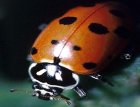Buying and protecting ladybirds
The British ladybird is under threat from an alien species. Milly Cumming explains what you can do to help and where you can buy larvae and adult insects


* For information about buying ladybirds, see bottom
Britain’s native ladybird is traditionally the gardener’s friend. It’s a voracious predator, and will rid plants of greenfly, whitefly, mealy bugs and coccids. But our ladybird is under threat from an alien species. Deliberately introduced from Asia into mainland Europe as a form of pest control, the harlequin ladybird found its way over to Britain on the wind and on imported plants. It was first spotted here in 2004, and, since then, its numbers have increased dramatically. It now poses a threat to our insect-eating birds by devouring their food supply.
The harlequin’s diet consists of lacewing larvae, butterfly eggs, moths, pollen, and caterpillars, not to mention our own native ladybirds eating them to the point of extinction. These insatiable creatures also cause considerable damage to pear trees, soft fruit and sweet peas.
At the top of their food chain, harlequins have no natural enemies in Britain. They secrete a foul-smelling, toxic substance that deters any bird from eating them. Found in large groups, they leave chemical traces so that other harlequins can find them, and, being fiercely terri-torial, they kill any other breeds of ladybird as soon as they encounter them.
This ravaging species is being spread around the country in much the same way it came in the first place by the transport of produce. It has an amazing potential for swift geographic expansion.
Peter Brown, of the Biological Records Centre in Huntingdon, says: ‘Invasive species are one of the most serious threats to biodiversity worldwide. The very rapid spread of the harlequin in Europe is likely to have a serious impact on native ladybirds and, potentially, many other insects. The species is also a human nuisance and should not have been released in Europe.’
Unfortunately, there’s no easy solution to the problem. As there’s no way of getting rid of them naturally, the only answer seems to be to take matters into our own hands. However, apart from physically removing or killing them, keeping harlequins under control is tricky. Chemical sprays can’t be used without harming other species, and, currently, there’s no method that will target only harlequins. Nevertheless, research is being carried out to develop a way of controlling them with a pheromone that attracts only harlequins.
Sign up for the Country Life Newsletter
Exquisite houses, the beauty of Nature, and how to get the most from your life, straight to your inbox.
In the meantime, the most helpful thing anyone can do is to report any sightings on the UK Harlequin Ladybird Survey, compiled by the Centre for Ecology and Hydrology (CEH), Cambridge Univer-sity and Anglia Ruskin University. Recognising them isn’t hard; they’re usually black with two or four red spots, or red or tan with several rows of small black spots across the back. So start counting. To report sightings of harlequin ladybirds, visit www.harlequin-survey.org
HOW TO GIVE OUR NATIVE LADYBIRDS A BOOST
* Buy native ladybird larvae or adult insects as pest control for your garden
* make sure they’re native to the UK or, specifically, to your area
* Release them before dawn or after sunset, because they use the sun to navigate and tend to remain still during the early mornings and evenings.
* Pre-water the area where you’re going to release them. Moisture on the leaves will help the ladybirds to ‘stick’ to the plants
* Umbrella-shaped flowers such as fennel, dill, cilantro, caraway, tansy, wild carrot and yarrow are favourites of native ladybirds, as well as dandelions and scented geraniums
* There are more than 5,000 species of ladybirds worldwide, 46 of which are native to the UK
* More than 20,000 harlequin ladybirds have been logged since March 2005
* The Latin name for the harlequin is Harmonia axyridis and the Latin name for the most common native ladybird is Coccinella septempunctata (seven-spotted ladybird)
HOW TO BUY LADYBIRD LARVAE OR ADULT INSECTS
Call Gardening Naturally (0845 680 0296 or 01285 654241) to buy your native ladybird larvae or adult insects.
Adult insects – approx 25 (will treat an area of 5m squared) - £14.95
Ladybird larvae – approx 30 (will treat an area of 5m squared) - £9.95
Ladybird larvae – approx 250 (will treat an area of 40m squared) - £39.49
100 larvae in a release bag for a tree - £19.94
Ladybird house - £13.50
You can also buy ladybird houses from the National Trust - National Trust shop (0844 557 5384)
Country Life is unlike any other magazine: the only glossy weekly on the newsstand and the only magazine that has been guest-edited by HRH The King not once, but twice. It is a celebration of modern rural life and all its diverse joys and pleasures — that was first published in Queen Victoria's Diamond Jubilee year. Our eclectic mixture of witty and informative content — from the most up-to-date property news and commentary and a coveted glimpse inside some of the UK's best houses and gardens, to gardening, the arts and interior design, written by experts in their field — still cannot be found in print or online, anywhere else.
-
 How an app can make you fall in love with nature, with Melissa Harrison
How an app can make you fall in love with nature, with Melissa HarrisonThe novelist, children's author and nature writer Melissa Harrison joins the podcast to talk about her love of the natural world and her new app, Encounter.
By James Fisher
-
 'There is nothing like it on this side of Arcadia': Hampshire's Grange Festival is making radical changes ahead of the 2025 country-house opera season
'There is nothing like it on this side of Arcadia': Hampshire's Grange Festival is making radical changes ahead of the 2025 country-house opera seasonBy Annunciata Elwes